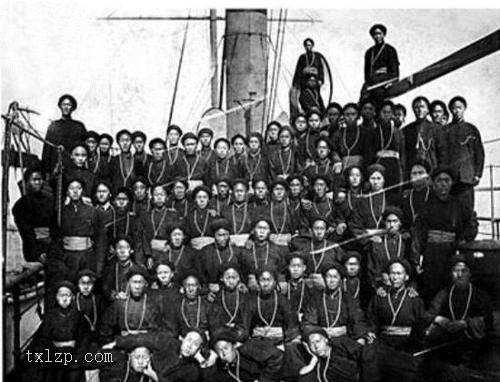Share a group of old photos taken in 1930 in Baotou, Inner Mongolia. Let’s take a look at the life style of the people along the Yellow River in Baotou 90 years ago, and feel the prosperous commercial and trade scene and the scenes inside and outside Wudangzhao. This group of photos is from the Japanese miscellaneous chronicle “Yadong Prints Collection” issued from August 1924 to 1944
The issue date of the magazine where the photos of this group were taken was January 1930, so the photos of this group were taken before January 1930
Baotou is a Mongolian language“ Baoke Chart” It is also called Jiuyuan and Lucheng. Baotou has a long history. It is the communication hub between the nomadic culture of the northern grassland and the farming culture of the Central Plains. Jiuyuan City was built in 306 BC; In 221 BC, Jiuyuan County was established; In 433, the Northern Wei Dynasty, established by the Xianbei nationality, set up Huaishuo Town
In the Qing Dynasty, Baotou Town was established in 1809, becoming a trade distribution center connecting Mongolia, Xinjiang and Gansu. Around the ninth year of Tongzhi in the Qing Dynasty (1870), Baotou built a city wall and opened five gates in the east, south, west, northeast and northwest, forming the modern city scale of Baotou. From the late 19th century to the early 20th century, Baotou has developed into a famous fur distribution center and flood and drought wharf in northwest China. The grand scene of its trade can be fully demonstrated through this group of photos
The following is a preview of this group of photos:
![图片[1]-The old photo of Baotou, Inner Mongolia in 1930, The style and features of the Yellow River bank and Wudangzhao-China Archive](https://chinaarchive.net/photo/republic-of-china/1-211006212129.jpg)
包头 黄河岸边 大量的皮筏子等待装货运输
![图片[2]-The old photo of Baotou, Inner Mongolia in 1930, The style and features of the Yellow River bank and Wudangzhao-China Archive](https://chinaarchive.net/photo/republic-of-china/1-211006212130.jpg)
包头 黄河岸边 正在制作羊皮筏子的船夫
![图片[3]-The old photo of Baotou, Inner Mongolia in 1930, The style and features of the Yellow River bank and Wudangzhao-China Archive](https://chinaarchive.net/photo/republic-of-china/1-211006212130-50.jpg)
包头 黄河岸边 牛皮筏子
![图片[4]-The old photo of Baotou, Inner Mongolia in 1930, The style and features of the Yellow River bank and Wudangzhao-China Archive](https://chinaarchive.net/photo/republic-of-china/1-211006212130-51.jpg)
包头 黄河岸边 充满气的牛皮
![图片[5]-The old photo of Baotou, Inner Mongolia in 1930, The style and features of the Yellow River bank and Wudangzhao-China Archive](https://chinaarchive.net/photo/republic-of-china/1-211006212130-52.jpg)
包头 黄河岸边 停靠着大量运货船只。
![图片[6]-The old photo of Baotou, Inner Mongolia in 1930, The style and features of the Yellow River bank and Wudangzhao-China Archive](https://chinaarchive.net/photo/republic-of-china/1-211006212130-53.jpg)
织羊毛,应该是在编织羊毛麻袋
![图片[7]-The old photo of Baotou, Inner Mongolia in 1930, The style and features of the Yellow River bank and Wudangzhao-China Archive](https://chinaarchive.net/photo/republic-of-china/1-211006212131.jpg)
包头 运输货物的骆驼队
![图片[8]-The old photo of Baotou, Inner Mongolia in 1930, The style and features of the Yellow River bank and Wudangzhao-China Archive](https://chinaarchive.net/photo/republic-of-china/1-211006212131-50.jpg)
包头城
![图片[9]-The old photo of Baotou, Inner Mongolia in 1930, The style and features of the Yellow River bank and Wudangzhao-China Archive](https://chinaarchive.net/photo/republic-of-china/1-211006212131-51.jpg)
包头土城墙
![图片[10]-The old photo of Baotou, Inner Mongolia in 1930, The style and features of the Yellow River bank and Wudangzhao-China Archive](https://chinaarchive.net/photo/republic-of-china/1-211006212131-52.jpg)
包头 塞外露天市场
以下三张照片出自1930年3月的杂志,主要拍摄的是五当召。
五当召,蒙古语“五当”意为“柳树”;原名巴达嘎尔召,藏语“巴达嘎尔”意为“白莲花”,“召”为“庙宇”之意。始建于清康熙年间(公元1662年—1722),乾隆十四年(公元1749年)重修,赐汉名广觉寺。第一世活佛罗布桑加拉措以西藏扎什伦布寺为蓝本兴建,经过康熙、乾隆、嘉庆、道光、光绪年间的多次扩建,逐步扩大至今日规模。 因建在五当沟的一座叫做敖包山的山坡上,所以通称其名为五当召。
![图片[11]-The old photo of Baotou, Inner Mongolia in 1930, The style and features of the Yellow River bank and Wudangzhao-China Archive](https://chinaarchive.net/photo/republic-of-china/1-211006214010.jpg)
五当召的僧侣宿舍
![图片[12]-The old photo of Baotou, Inner Mongolia in 1930, The style and features of the Yellow River bank and Wudangzhao-China Archive](https://chinaarchive.net/photo/republic-of-china/1-211006214011.jpg)
五当召是一幢层层依山垒砌的白色建筑,群山环绕,为苍松翠柏掩映,雄浑壮观。
![图片[13]-The old photo of Baotou, Inner Mongolia in 1930, The style and features of the Yellow River bank and Wudangzhao-China Archive](https://chinaarchive.net/photo/republic-of-china/1-211006214011-50.jpg)
五当召内的念经堂。
苏古沁独宫坐落全召的最前部,是举行全体集会诵经的场所。经堂内的立柱全用龙纹的栽绒毛毯包裹,地上满铺地毯,墙壁绘有彩色壁画,后厅及二、三层内供奉释迦牟尼、宗喀巴及历代佛师。



![[Qing Dynasty] British female painter—Elizabeth Keith, using woodblock prints to record China from the late Qing Dynasty to the early Republic of China—1915-China Archive](https://chinaarchive.net/wp-content/uploads/2022/11/image-191x300.png)

